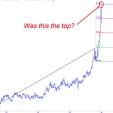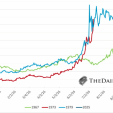Shades Of Black Monday October 19, 1987?
The good news is: The Federal Reserve Bank (Fed) is likely to intervene to prop up the market early next week.
The week before the crash in 1987 was, like this past week, a bad one for the market and, like this past week, Friday was the worst day of the week. The following Monday the market crashed. On that infamous Black Monday October 19, 1987, stock markets around the world crashed, shedding a huge value in a very short time. The Dow Jones Industrial Average (DJIA) fell exactly 508 points to 1,739 (effectively losing -23% in one single day!). However, on Tuesday the Fed stepped in and offered unlimited liquidity to everyone who needed it and the crisis was averted. Since then the Fed has responded to every market hiccup with liquidity and lower interest rates. Since interest rates have hit 0% the Fed has used Quantitative Easing (QE) to flood the market with liquidity. The most recent QE program ended last October, but the Fed's balance sheet has continued to expand although at a slower rate. Now liquidity has dried up and the market is in trouble. St Louis Fed President James Bullard reportedly called QE successful because it drove the dollar down and the market up. It is unlikely there will be any rate hike in the near future and another round of QE would not surprise me.
The negatives: On Friday there were 627 new lows (19% of issues traded) on the NYSE and 345 (12%) on the NASDAQ. These are bear market numbers.
The charts all cover the past year to give a longer term perspective on what is happening.
The first chart shows the NASDAQ composite (OTC) in blue and a 10% trend (19 day EMA) of NASDAQ new highs (OTC NH), in green. Dashed vertical lines have been drawn on the 1st trading day of each month.
OTC NH has not caught up yet; there were fewer new highs on Friday and at any time shown on the chart.

The next chart is similar to the one above except it shows the S&P 500 (SPX) in red and NY NH has been calculated from NYSE data.
There were no new highs on the NYSE Friday, a rare event.

The next chart shows the SPX in red and a 40% trend (4 day EMA) of NYSE new highs divided by new highs + new lows (NY HL Ratio), in blue. Dashed horizontal lines have been drawn at 10% levels for the indicator, the line is solid at the 50%, neutral level.
NY HL Ratio is at a point from which, at least, a short term rally often begins.

The next chart is similar to the one above except it shows the OTC, in blue, and OTC HL Ratio, in red, has been calculated from NASDAQ data.
OTC HL Ratio is only slightly stronger than NY HL Ratio, but the levels are at extremes.

Advance - Decline Lines (ADL) are running totals of declining issues subtracted from advancing issues. ADL's behave differently in different markets. What we look for are changes in character.
The chart below shows the SPX in red and an ADL calculated from NYSE issues in blue.
The NYSE ADL has had a wildly positive bias for the past decade, that bias shifted late last April and the ADL failed to confirm the all-time high of the SPX in May. It is now leading the way down.

The next chart is similar to the one above except is shows the OTC in blue and OTC ADL has been calculated from NASDAQ data.
OTC ADL has not had the strong positive bias of the NYSE ADL, but the pattern is similar. OTC ADL began weakening in late April and went very negative in late June.

New lows are the best indicator of bottoms they disappear shortly after a bottom has been reached.
The chart below shows the SPX in red and a 10% trend (19 day EMA) of NYSE new lows (NY NL), in blue. NY NL has been plotted on an inverted Y axis so decreasing new lows move the indicator upward (up is good).
For the past 2 months we have seen some short term relative reductions in the number of new lows, enough to turn the indicator upward, but levels have remained high.

The next chart is similar to the one above except is shows the OTC in blue and OTC NL has been calculated with NASDAQ data.
There is no reason to think a bottom has been reached.

The positives: There are no technical positives.
Money supply (M2)
The money supply chart was provided by Gordon Harms.
M2 growth has been on its trend.

Conclusion
There is no sign of a bottom, but I expect the Fed to intervene.
I expect the major averages to be higher on Friday August 28 than they were on Friday August 21.
Last week's positive forecast was a miss.
********
This report is free to anyone who wants it, so please tell your friends.
They can sign up at: http://www.stockmarket-ta.com/signup.html
Disclaimer: Charts and figures presented herein are believed to be reliable but I cannot attest to their accuracy. Recent (last 10-15 yrs.) data has been supplied by CSI (csidata.com), FastTrack (fasttrack.net), Quotes Plus and the Wall Street Journal (wsj.com). Historical data is from Barron's and ISI price books. The views expressed dare provided for information purposes only and should not be construed in any way as investment advice. Furthermore, the opinions expressed may change without notice.

















